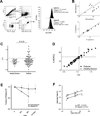Computational algorithm-driven evaluation of monocytic myeloid-derived suppressor cell frequency for prediction of clinical outcomes
- PMID: 24844912
- PMCID: PMC4125466
- DOI: 10.1158/2326-6066.CIR-14-0013
Computational algorithm-driven evaluation of monocytic myeloid-derived suppressor cell frequency for prediction of clinical outcomes
Abstract
Evaluation of myeloid-derived suppressor cells (MDSC), a cell type implicated in T-cell suppression, may inform immune status. However, a uniform methodology is necessary for prospective testing as a biomarker. We report the use of a computational algorithm-driven analysis of whole blood and cryopreserved samples for monocytic MDSC (m-MDSC) quantity that removes variables related to blood processing and user definitions. Applying these methods to samples from patients with melanoma identifies differing frequency distribution of m-MDSC relative to that in healthy donors. Patients with a pretreatment m-MDSC frequency outside a preliminary definition of healthy donor range (<14.9%) were significantly more likely to achieve prolonged overall survival following treatment with ipilimumab, an antibody that promotes T-cell activation and proliferation. m-MDSC frequencies were inversely correlated with peripheral CD8(+) T-cell expansion following ipilimumab. Algorithm-driven analysis may enable not only development of a novel pretreatment biomarker for ipilimumab therapy, but also prospective validation of peripheral blood m-MDSCs as a biomarker in multiple disease settings.
Trial registration: ClinicalTrials.gov NCT00495066 NCT00920907.
©2014 American Association for Cancer Research.
Conflict of interest statement
A.M.L. and J.D.W. have a patent pending entitled "Prediction of Responsiveness to Treatment with Immunomodulatory Therapeutics and Method of Monitoring Abscopal Effects During Such Treatment". A.M.L, M.A.P., and J.D.W. receive research funding on behalf of their institution and consult for Bristol Myers-Squibb.
Figures


References
-
- Poschke I, Kiessling R. On the armament and appearances of human myeloid-derived suppressor cells. Clin Immunol. 2012;144:250–268. - PubMed
-
- Young MR, Wright MA, Lozano Y, Prechel MM, Benefield J, Leonetti JP, et al. Increased recurrence and metastasis in patients whose primary head and neck squamous cell carcinomas secreted granulocyte-macrophage colony-stimulating factor and contained CD34+ natural suppressor cells. Int J Cancer. 1997;74:69–74. - PubMed
-
- Filipazzi P, Valenti R, Huber V, Pilla L, Canese P, Iero M, et al. Identification of a new subset of myeloid suppressor cells in peripheral blood of melanoma patients with modulation by a granulocyte-macrophage colony-stimulation factor-based antitumor vaccine. J Clin Oncol. 2007;25:2546–2553. - PubMed
Publication types
MeSH terms
Substances
Associated data
Grants and funding
LinkOut - more resources
Full Text Sources
Other Literature Sources
Medical
Research Materials

